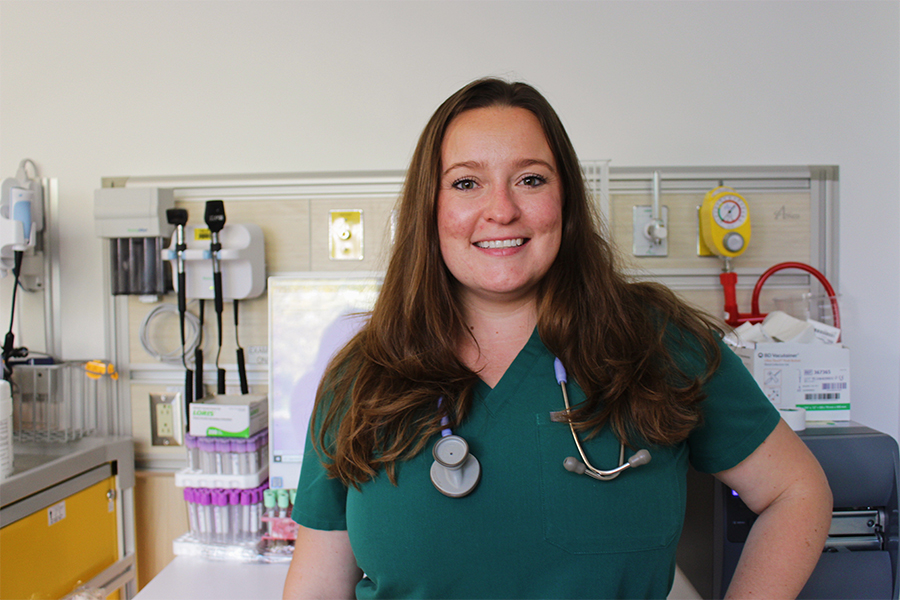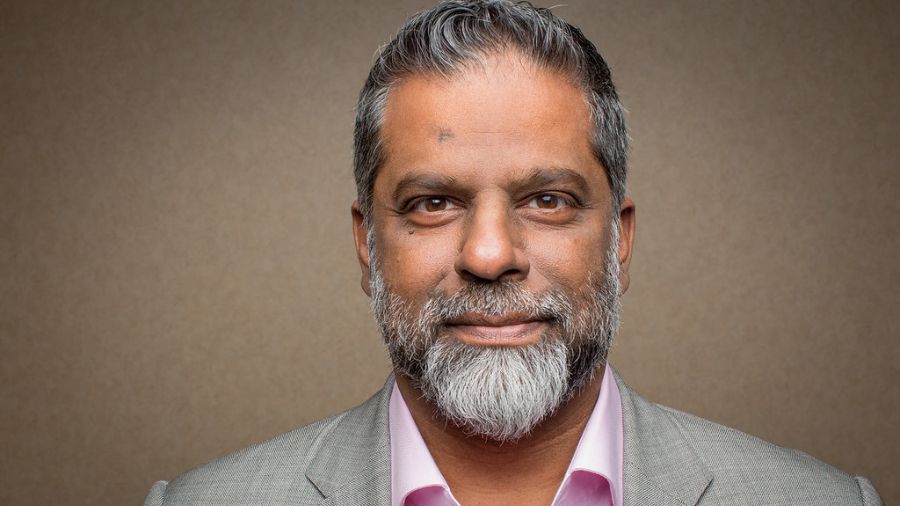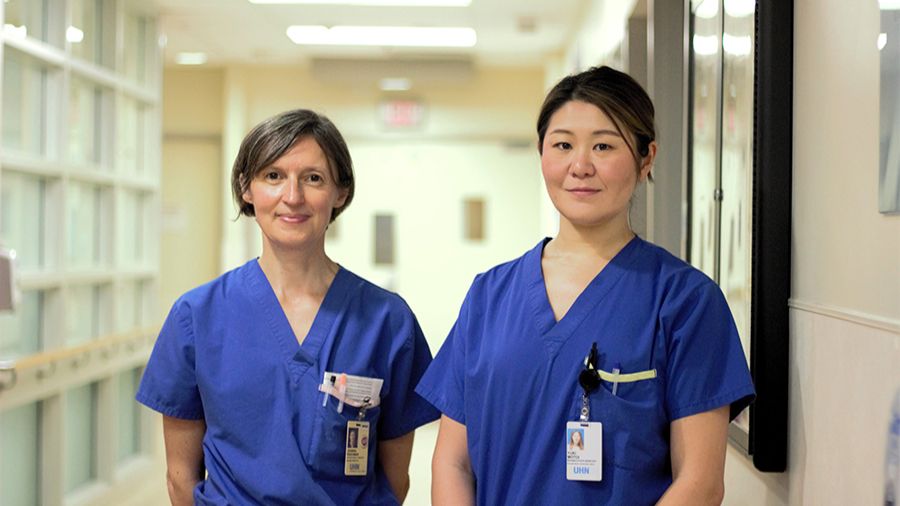Jas Dhillon, a respiratory therapist at UHN since 2015. (Photo: UHN)
The first sign of progress is subtle – as Jas Dhillon arrives at the Respiratory Therapy Department on the 10th floor at Toronto General Hospital (TGH) just after 7 a.m., a large number of ventilators are crowded into one corner, not far from the staff lounge. Being in storage means they’re not needed for patients.
The second sign, which comes nearly 10 hours later, is more obvious – Jas and the rest of team on the Medical Surgical Intensive Care Unit (MSICU) are summoned to the Nursing Station where they learn that for the first time since March 26, 2020 there are no “active” COVID-19 patients. It’s a milestone marked with prolonged applause.
But for the remainder of this day in mid-June – and many days and weeks to come – there’s another reality of COVID-19 in the TGH MSICU that’s easy to forget amid the statistics. The battle against the disease is still fully engaged here, as multi-disciplinary teams care for many patients who are critically ill.
“Yes, the number of cases is going down. Yes, the number of active patients in the ICUs is lower much lower than it was,” says Jas, a respiratory therapist at UHN since graduating from the Michener Institute of Education at UHN in 2015. “However, there are still patients who are very sick as a result of COVID.
“That’s the unfortunate reality. And, we’re still caring for them to the best of our ability.”
Nearly a year-and-a-half into the pandemic, one of its most enduring medical symbols is a ventilator. COVID-19 is a respiratory infection, which can make it difficult to breathe because the lungs become so inflamed. The ventilator is a machine that helps patients inhale oxygen and exhale carbon dioxide when they cannot do it on their own. It keeps them alive when they would otherwise suffocate.
Critical care teams typically connect people to a ventilator through a process known as intubation. The oxygen flows through a tube which goes into the patient’s mouth and down their windpipe. The person is most often medically paralyzed and sedated – a medically-induced coma – when on ventilator to relax their body.
One of the key roles of a respiratory therapist (RT) during the pandemic is caring for ventilated patients.
Across five sites at UHN, more than 120 RTs care for the airway management, or breathing, of a wide variety of patients. Their work extends from ICUs, operating rooms and the Emergency Departments to general hospital wards, complex continuing care, pulmonary rehabilitation, cancer care and the hyperbaric chamber.
Putting a patient on a ventilator is considered a last resort. During the pandemic, virtually every COVID patient in the MSICU has required mechanical ventilation.
And, during each of the three waves, as the MSICU became overwhelmed and the most critically-ill COVID patients also began to occupy the Cardiovascular Intensive Care Unit (CVICU) and the Coronary Intensive Care Unit (CICU), Jas says for the first time during his career at UHN they had to borrow ventilators from the Ontario Ministry of Health to be able to keep up with their needs.
The demands of the past 16 months have pushed the RTs – like all other health professions – to new limits. They’ve been challenged not only in terms of the number of sick patients they see but also in the high degree of acuity of those patients. COVID-19 can cause lung complications such as pneumonia, and in the most severe cases, acute respiratory distress syndrome (ARDS), which requires more intervention.
“What I noticed during each successive wave was that patients got sicker and they got younger, especially during the third wave,” Jas says. “And, many of them had been previously healthy.”
That became particularly personal for Jas, who is 32 and grew up in Brampton. Throughout the pandemic, the MSICU at TGH has accepted many of the sickest COVID patients from across the Greater Toronto Area, including those transferred in from other hospitals in his home town.
“Lots of these patients look like me,” he says. “At first, many reminded me of my parents, then we were getting more around my age, even younger, which reminded me of my friends.
“Every time I saw that, it hit closer to home. It made me realize this is real, it’s happening.”
And, it’s still happening. While volumes of COVID-19 cases have certainly eased and hospitalizations are down sharply from their peak of the third wave earlier this spring, many patients remain on ventilators.
On this day, Jas is one of five RTs working on the MSICU. Each has specific patients they will monitor throughout their 12-hour shift, but they are also quick to respond to the needs of their colleagues. Throughout the day, they check in on each other, cover breaks, lend an extra hand whenever needed.
“That team dynamic has always been there, not only with the RTs but with the entire interdisciplinary team,” Jas says. “But COVID has certainly heightened that.
“We rely on each other, fill in the gaps for each other.”
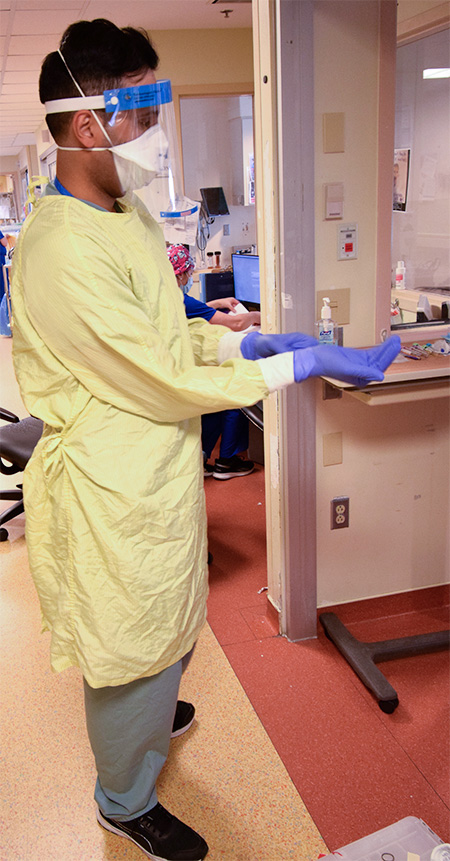
This is the third straight day shift for Jas. As the team tries to keep the continuity of care, he has the same six patients again today – four who are recovering from COVID-19, one whose case is still active and one who had a transplant the previous day. All are sedated and on ventilators. Some are paralyzed.
At the 7:15 a.m. handover with his colleague, he gets a detailed status update on each of the six patients, learning that it was a pretty uneventful 12 hours for each of them.
“They were stable overnight,” Jas says. “But it doesn’t mean they’re getting better, unfortunately.
“It just means that they’re status quo.”
At 8:05 a.m., Jas begins a thorough examination of his first patient. Even though the patient, who is in his 30s, is no longer considered to have an active case of COVID-19, Jas puts on full personal protective equipment (PPE) because he will be conducting procedures that can generate aerosol fluids.
The patient, transferred to UHN from another Toronto hospital more than a month earlier, is on ECMO – the extracorporeal membrane oxygenation machine that does the job of the lungs to allow them to rest and recover from COVID-19. It siphons off a portion of the person’s blood, passes it through a circuit to remove carbon dioxide and infuse oxygen, before returning it to the bloodstream through another vein.
Jas analyzes measurement of the patient’s blood-oxygen levels. He conducts tracheostomy, or trach, care, which includes cleaning the skin around the tracheostomy, suctioning out secretions from the trach tube and changing the inner cannula. He performs respiratory measurements on the ventilator and changes the ventilator settings to ensure the patient is ventilated safely.
As he goes through each step of a process that lasts about 20 minutes, Jas explains to the unresponsive patient exactly what he’s doing. Each clinician does the same thing every time they’re in contact with him – partly out of a sign of dignity and respect, and also to orient the patient and help combat delirium.
“It’s human nature, too,” Jas says. “You want to comfort them, let them know you’re there for them.”
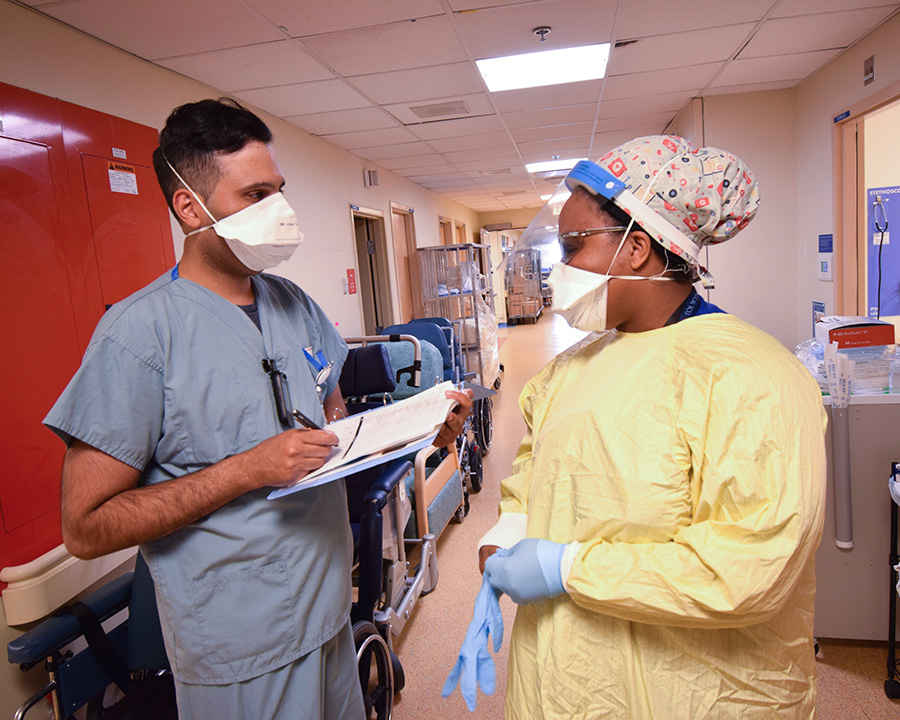
The examination of the first patient is similar to the ones Jas does on each of the other five in his care on this day. It’s a routine he will follow at least three times over the course of his 12-hour shift, though he will also visit each of the six patients to conduct different procedures or assist other clinicians in care.
At 9:45 a.m., the team begins rounds on the patients Jas is caring for on this day. Over the course of the next 90 minutes, the Critical Care team, led today by Dr. Margaret Herridge, gets detailed updates on each patient from the RN providing care. Then, with input from the nurse, RT, Clinical Fellow, Residents, pharmacist and others reviewing the patient’s status, the group collaborates on a care plan for the day.
“We have a great team, so they respect what we have to say about caring for patients,” Jas says.
During rounds, Jas gives his updates for one patient to Clinical Fellow Dr. Nima Kakho so he can leave the group to multi-task. A patient who is proned – turned on their stomach where they lie for up to 16 hours – needs to be turned over. Proning helps distribute breathing more evenly and protects the lungs.
While a Resident stands outside the room just in case there’s a complication, Jas holds the head of the patient, who is in their 50s and recovering from COVID-19, to ensure the breathing tube stays in place. As he does that, three RNs and a hospital assistant (more commonly known as a porter) complete a three-part process to turn the patient.
“We weren’t experienced in proning patients in Wave One,” Jas says. “Now, we’re like poetry in motion.”
Before heading back to join rounds, Jas goes into the room of the transplant patient. A vital step in the process of moving them out of MSICU is to test the lungs – which were not the organs transplanted the previous day – to ensure the patient is able to breathe on their own. If the patient passes by being able to breathe with minimal ventilator support for 45 minutes, then the ventilator will be removed.
At 12:30 p.m., Jas is working with RN Penny Macri to prepare one of the patients for a CT scan of the chest on the first floor. The patient, in their 40s, has been on a ventilator for more than three months and is experiencing particularly laboured breathing. The team is hoping to understand why.
“We’re going on a road trip, giving you a little change of scenery,” Penny cheerily tells the unresponsive patient as she and Jas transfer them to portable life supporting equipment for the trip.
The round trip and CT scan take about 40 minutes with the help of two hospital porters to transport the patient. The entire time, Jas and Penny never take their eyes off the patient or portable monitors.
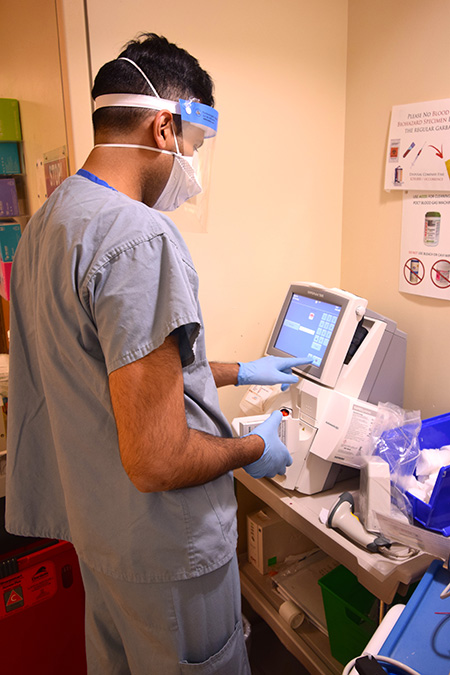
At 2:15 p.m., Jas is back in the room of the transplant patient, who passed the earlier breathing test. Clad in PPE, he tapes a sign on the door that reads “Aerosol Generating Medical Procedure” and plugs in in a portable HEPA filter to help purify the air before taking the patient off the ventilator.
“This is one of my favourite parts of this job, taking out a breathing tube,” Jas says following the procedure. “It’s nice to talk to a patient after taking it out. It’s very satisfying.”
Just before 4 p.m., Jas answers a call on the RT team pager and heads across the MSICU. His colleague, Dannah Shillingford, the team leader for the day, is tied up with another patient, so Jas is going to assist an ICU nurse and thoracic surgeon in changing the trach tube of a patient.
“Thank you for coming to rescue us,” the RN says to Jas as he puts on PPE before heading into the room.
While Jas completes that procedure, Dannah arrives outside the room. She’s preparing for the arrival of a new transplant patient from another hospital and wants to make sure Jas doesn’t need any help.
“He was my student,” Dannah says of Jas. “I am so very proud of him and the RT he has become.
“He cares so much about his patients and about our team.”
As Jas sees it, there’s no other way to work.
“We use each other as a resource everyday,” he says. “Everyone knows they cannot do it on their own.
“Everyone is involved, across all disciplines, because that’s what works best for our patients.”
Throughout the pandemic, generous donor support through UHN Foundation has helped protect UHN’s frontline workers, fuel vital research and enhance patient care to save more lives.

